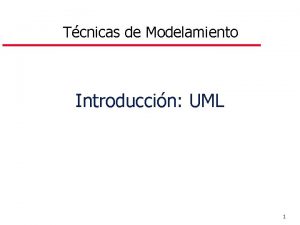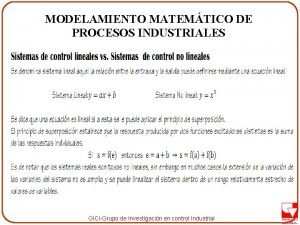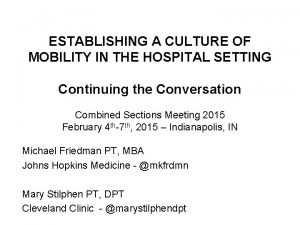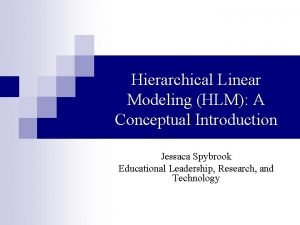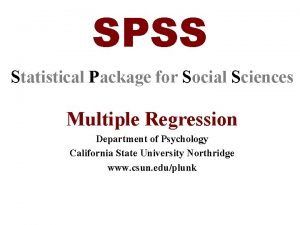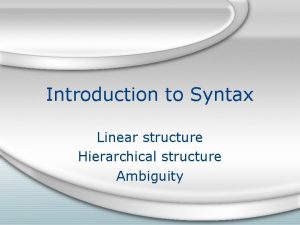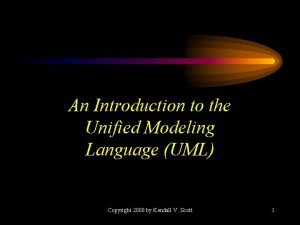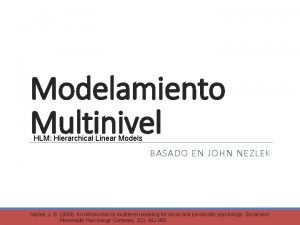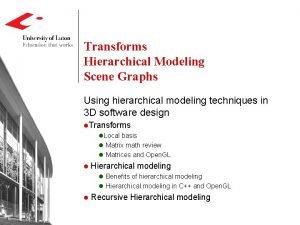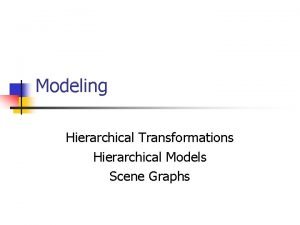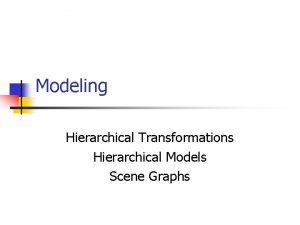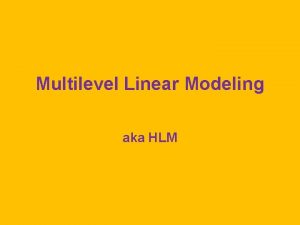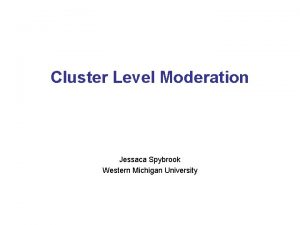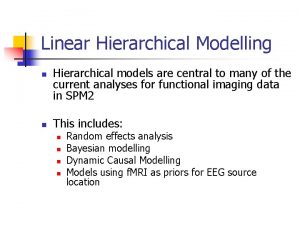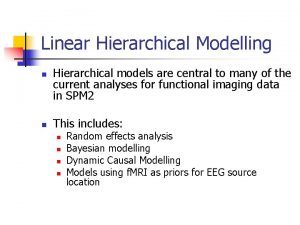Hierarchical Linear Modeling HLM A Conceptual Introduction Jessaca












- Slides: 12

Hierarchical Linear Modeling (HLM): A Conceptual Introduction Jessaca Spybrook Educational Leadership, Research, and Technology

Overview What is hierarchical data? n Why is it a problem for analysis? n ¨ Example Modeling the hierarchical structure n Example n ¨ 1 student level predictor, 2 school level predictors n Questions Slide 2

What is hierarchical (nested) data? n Examples ¨ Kids in classrooms in schools in districts ¨ Workers in firms ¨ Patients in doctors offices ¨ Repeated measures on individuals ¨ Other examples? Slide 3

Why is it problematic? n What is the relationship between SES and math achievement? ¨ Dependent variable: Math achievement ¨ Independent variable: Student SES n Case 1: 1 School (school A) ¨ School A Mean achievement: n SES achievement slope: n Slide 4

Why is it problematic? n Case 2: 1 school (School B) ¨ School B Mean achievement: n SES-achievement slope: n n Case 3: 160 schools ¨ 160 means, mean varies ¨ 160 SES-achievement slope parameters, slope varies ¨ Within school variation Slide 5

Why is it problematic? n Case 3: 160 schools ¨ Option A: Ignore nesting Violate assumptions for traditional linear model n Standard errors too small n ¨ Option n Lose information ¨ Option n B: Aggregate to school level C: Model the hierarchical structure Hierarchical linear models, multilevel models, mixed effects models, random coefficient models Slide 6

Modeling the hierarchical structure n Advantages ¨ Improved estimation of individual (school effects) ¨ Test hypotheses for cross level effects ¨ Partition variance and covariance among levels Slide 7

Example n Results – what do they mean? Fixed Effect Coefficient Standard Error t-ratio p-value Overall mean achievement 12. 64 0. 24 51. 84 <0. 001 Mean SES-ach slope 2. 19 0. 13 17. 16 <0. 001 Random Effects Variance Df Chi-square p-value School means, u 0 j 8. 68 159 1770. 86 <0. 001 SES-ach slope, u 1 j 0. 68 159 213. 44 0. 003 Within school, rij 36. 70 Slide 8

Example n School-level predictors ¨ Do Catholic schools differ from public schools in terms of mean achievement (controlling for school mean ses)? ¨ Do Catholic schools differ from public schools in terms of strength of association between student SES and achievement (controlling for school mean ses)? Slide 9

Example n School level predictors Slide 10

Example n Results – what do they mean? Fixed Effect Coefficient Standard Error t-ratio p-value Intercept 12. 09 0. 17 69. 64 <0. 001 Catholic 1. 23 0. 31 3. 98 <0. 001 MEAN SES 5. 33 0. 33 15. 94 <0. 001 Intercept 2. 94 0. 15 19. 90 <0. 001 Catholic -1. 64 0. 24 -6. 91 <0. 001 MEAN SES 1. 03 0. 33 3. 11 0. 002 Model for school means Model for SES-ach slope Slide 11

Example n Visual Look Slide 12
 Uml 1
Uml 1 Control de nivel de tanque
Control de nivel de tanque Hopkins mobility scale
Hopkins mobility scale Hlm visual emaple
Hlm visual emaple Hierarchical modeling in computer graphics
Hierarchical modeling in computer graphics Hierarchical modeling in computer graphics
Hierarchical modeling in computer graphics Model and role modeling theory
Model and role modeling theory Relational vs dimensional data modeling
Relational vs dimensional data modeling Hierarchical multiple regression spss
Hierarchical multiple regression spss What is linear hierarchy
What is linear hierarchy Linear and quadratic functions and modeling
Linear and quadratic functions and modeling Introduction to the unified modeling language
Introduction to the unified modeling language Introduction to modeling and simulation
Introduction to modeling and simulation
